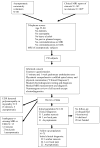A prospective, masked 18-month minimum follow-up on neurophysiologic changes in persons with spinal stenosis, low back pain, and no symptoms
- PMID: 19627886
- PMCID: PMC2735230
- DOI: 10.1016/j.pmrj.2008.10.007
A prospective, masked 18-month minimum follow-up on neurophysiologic changes in persons with spinal stenosis, low back pain, and no symptoms
Abstract
Objectives: To describe neurophysiologic changes over time in persons with and without spinal complaints and to assess whether paraspinal denervation predicts change in stenosis on magnetic resonance imaging (MRI) and clinical course.
Design: Prospective, controlled, masked trial.
Setting: University spine program.
Participants: Persons aged 55 to 80 years, screened for polyneuropathy and determined on clinical examination to have spinal stenosis, mechanical low back pain, or no spinal symptoms.
Interventions: A comprehensive codified history was obtained and subjects underwent physical examination, ambulation testing, masked electrodiagnostic testing including paraspinal mapping, and MRI, repeated at greater than 18 months. This study presents detailed technical information and additional analyses not reported previously.
Main outcome measurements: Change in electrodiagnostic findings. Among persons with clinical stenosis, relationship of change in paraspinal mapping scores to MRI findings and clinical changes.
Results: Of 149 initial subjects, 83 (79.3% of eligible subjects) repeated testing at 20 (+/-2 SDs) months. No significant change in limb muscle spontaneous activity or motor unit pathology was noted in any group. In 23 persons with initial diagnosis of stenosis, paraspinal mapping electromyography related to change in diagnosis over time (analysis of variance F = 3.77, P = .037), but not to most initial magnetic resonance imaging measurements or to change in spinal canal diameter.
Conclusions: Clinical spinal stenosis is neurophysiologically stable in most persons. Paraspinal electromyographic changes reflect large changes in clinical course, but neither neurophysiologic nor clinical changes relate to change in spinal geometry over 20 months.
Similar articles
-
Spinal stenosis, back pain, or no symptoms at all? A masked study comparing radiologic and electrodiagnostic diagnoses to the clinical impression.Arch Phys Med Rehabil. 2006 Jul;87(7):897-903. doi: 10.1016/j.apmr.2006.03.016. Arch Phys Med Rehabil. 2006. PMID: 16813774
-
The relation among spinal geometry on MRI, paraspinal electromyographic abnormalities, and age in persons referred for electrodiagnostic testing of low back symptoms.Spine (Phila Pa 1976). 2002 Sep 1;27(17):1918-25; discussion 1924-5. doi: 10.1097/00007632-200209010-00019. Spine (Phila Pa 1976). 2002. PMID: 12221358
-
Correlation of paraspinal atrophy and denervation in back pain and spinal stenosis relative to asymptomatic controls.PM R. 2013 Jan;5(1):39-44. doi: 10.1016/j.pmrj.2012.08.017. PM R. 2013. PMID: 23332908 Clinical Trial.
-
Paraspinal denervation and the spinal degenerative cascade.Spine J. 2002 Sep-Oct;2(5):372-80. doi: 10.1016/s1529-9430(02)00201-2. Spine J. 2002. PMID: 14589468 Review.
-
Diagnosis and Management of Lumbar Spinal Stenosis: A Review.JAMA. 2022 May 3;327(17):1688-1699. doi: 10.1001/jama.2022.5921. JAMA. 2022. PMID: 35503342 Review.
Cited by
-
Electrophysiological Characteristics of Cervical Spinal Stenosis.Appl Bionics Biomech. 2022 Jun 26;2022:7522664. doi: 10.1155/2022/7522664. eCollection 2022. Appl Bionics Biomech. 2022. Retraction in: Appl Bionics Biomech. 2023 Nov 29;2023:9815823. doi: 10.1155/2023/9815823. PMID: 35795257 Free PMC article. Retracted.
-
Symmetry of paraspinal muscle denervation in clinical lumbar spinal stenosis: support for a hypothesis of posterior primary ramus stretching?Muscle Nerve. 2013 Aug;48(2):198-203. doi: 10.1002/mus.23750. Epub 2013 Jun 28. Muscle Nerve. 2013. PMID: 23813584 Free PMC article. Clinical Trial.
References
-
- Aronow WS. Management of peripheral arterial disease. Cardiology in Review. 2005;13(2):61–8. - PubMed
-
- Atlas S, Chang Y, Wu Y, Keller R, Singer D. Predictors of longitudinal outcomes for patients with lumbar spinal stenosis followed over a 10 year period. International Society for the Study of the Lumbar Spine; New York. May 12; 2005. poster 106.
-
- Benoist M. The natural history of lumbar degenerative spinal stenosis. Joint, Bone, Spine: Revue du Rhumatisme. 2002;69(5):450–7. - PubMed
-
- Bijur PE, Silver W, Gallagher EJ. Reliability of the visual analog scale for measurement of acute pain. Academic Emergency Medicine. 2001;8(12):1153–1157. - PubMed
-
- Boden S, et al. Abnormal magnetic resonance scans of the lumbar spine in asymptomatic subjects. J bone Joint Surg. 1990;72A:403–408. - PubMed


